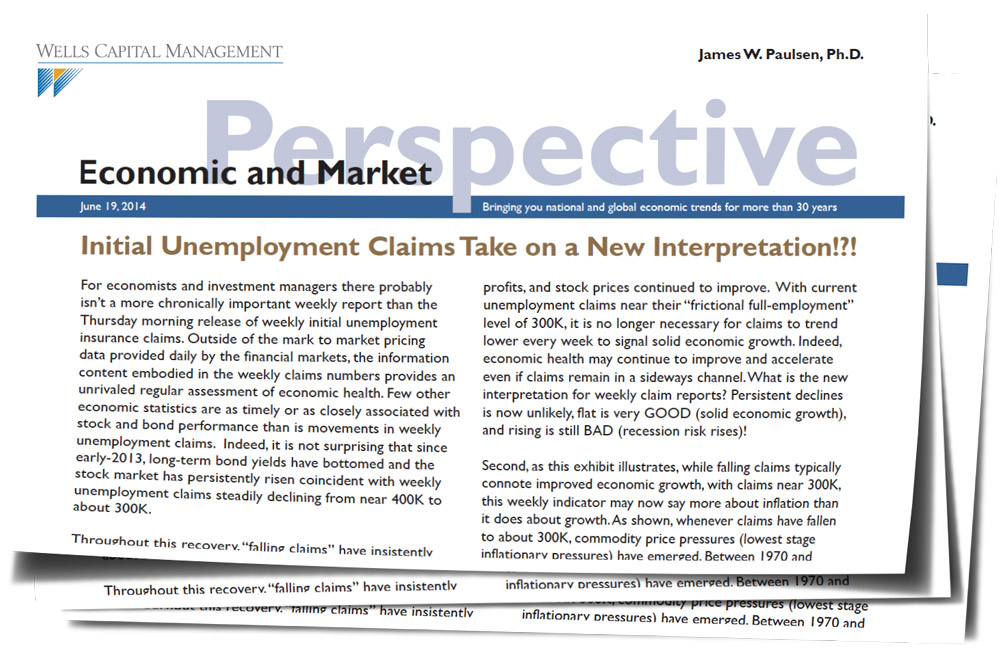Initial Unemployment Claims Take on a New Interpretation!?!
by James Paulsen, Chief Investment Strategist, Wells Capital Management
For economists and investment managers there probably isn’t a more chronically important weekly report than the Thursday morning release of weekly initial unemployment insurance claims. Outside of the mark to market pricing data provided daily by the financial markets, the information content embodied in the weekly claims numbers provides an unrivaled regular assessment of economic health. Few other economic statistics are as timely or as closely associated with stock and bond performance than is movements in weekly unemployment claims. Indeed, it is not surprising that since early-2013, long-term bond yields have bottomed and the stock market has persistently risen coincident with weekly unemployment claims steadily declining from near 400K to about 300K.
Throughout this recovery, “falling claims” have insistently been interpreted as evidence of improving economic health which has typically led to a higher stock market. As the enclosed exhibit suggests, however, this interpretation may be about to change. As shown in the top chart, unemployment claims are not likely to fall much lower. Today, claims of about 300K are near an all-time record low relative to the overall level of employment. Although claims did fall below 300K in the early-1970s, this was when the overall level of employment was only about one-half of what it is today. Consequently, relative to overall employment, claim levels of 300K in the early-1970s, would be equivalent to about 600K claims today. Similar to the unemployment rate being considered at full employment at about 4% (because there will always be some “frictional” unemployment even in a fully employed economy), unemployment claims at about 300K are also close to levels which may persist no matter how much lower the unemployment rate declines or how much faster job creation grows. That is, nearing 300K today, unemployment claims are probably close to “frictional lows” for this recovery cycle.
If, indeed, weekly claims are near frictional lows for the cycle (at about 300K), investors and economists should prepare for a few new interpretations of the weekly numbers. First, as shown by the top chart, unemployment claims may stop declining even though economic growth continues to improve. Since the mid-1970s, claims have flattened in every recovery cycle at around 275K to 325k even though economic growth, the unemployment rate, job creation, profits, and stock prices continued to improve. With current unemployment claims near their “frictional full-employment” level of 300K, it is no longer necessary for claims to trend lower every week to signal solid economic growth. Indeed, economic health may continue to improve and accelerate even if claims remain in a sideways channel. What is the new interpretation for weekly claim reports? Persistent declines is now unlikely, flat is very GOOD (solid economic growth), and rising is still BAD (recession risk rises)!
Second, as this exhibit illustrates, while falling claims typically connote improved economic growth, with claims near 300K, this weekly indicator may now say more about inflation than it does about growth. As shown, whenever claims have fallen to about 300K, commodity price pressures (lowest stage inflationary pressures) have emerged. Between 1970 and 1974, unemployment claims were persistently below 300K and commodity prices persistently rose. Since then, nearly every time claims have fallen to the level they are at today, commodity prices were near a significant low. Moreover, the S&P commodity price index has been flat to down since 2008 which, “not” coincidently, was the last time unemployment claims were near the same 300K level they are at today! One final thought regarding this exhibit. Movements in weekly unemployment claims are most commonly perceived as a significant “monitor” of real economic activity.
Perhaps this is indeed true ... until they reach their “frictionally fully-employed” level near 300K. Then, unemployment claims movements seem to lose their significant real growth signaling properties until they spike higher again, suggesting a pending recession. However, just as unemployment claims begin losing their real growth signaling properties (at around the 300K level), commodity prices (primarily dormant in the early part of most economic cycles when unemployment claims are still above 300K) seem to suddenly gain significant prowess in signaling “nominal” (or inflationary risks) economic activity. If this is true, as the attached exhibit implies, perhaps it is time for both the Fed and stock and bond investors to worry less about unemployment claims and instead, to focus more on the message coming from the commodity market?
Just a little something to ponder as we parse “Fed-Week” commentary!??!
James Paulsen - Investment Outlook June 19, 201420140619_EMP
Copyright © Wells Capital Management














